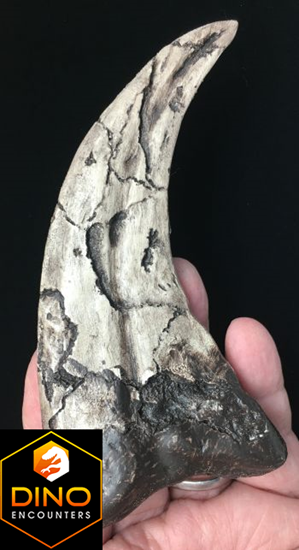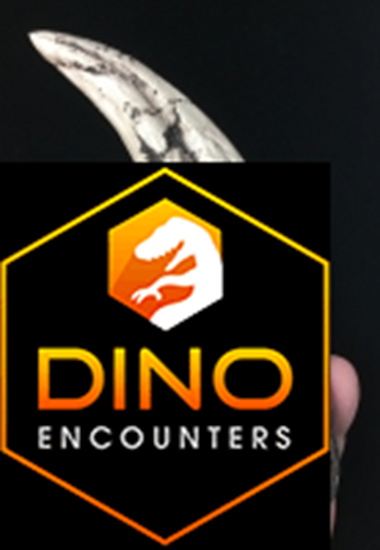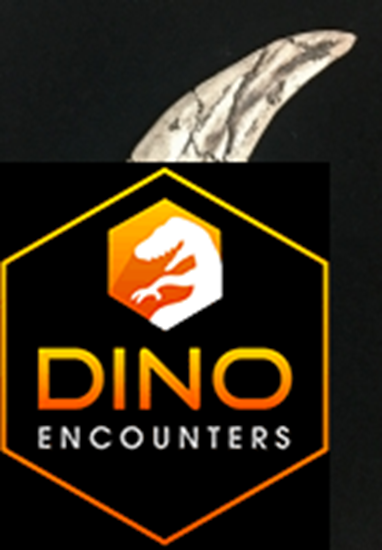Dino Encounters Store - Utahraptor claw, reconstruction
$18.00
Description
Slashing Claw from the 2nd Toe of the Hind Foot of Utahraptor.
Utahraptor (meaning "Utah's predator" is a genus of theropod dinosaurs. It contains a single species, Utahraptor ostrommaysorum, which is the largest known member of the family Dromaeosauridae. Fossil specimens date to the upper Barremian stage of the early Cretaceous period (in rock strata dated to 126 ± 2.5 million years ago).
The holotype specimen of Utahraptor is fragmentary, consisting of skull fragments, a tibia, claws and some caudal (tail) vertebrae. These few elements suggest an animal about twice the length of Deinonychus. Like other dromaeosaurids, Utahraptor had large curved claws on their second toes. One claw specimen is preserved at 22 centimeters (8.7 in) in length and is thought to reach 24 cm (9.4 in) restored.
The largest described U. ostrommaysorum specimens are estimated to have reached up to 7 meters (23 ft) long and somewhat less than 500 kilograms (1,100 lb) in weight, comparable to a polar bear in size.] However, the 2001 Kirkland discovery indicates the species may be far heavier than previously estimated.
Although feathers have never been found in association with Utahraptor specimens, there is strong phylogenetic evidence suggesting that all dromaeosaurids possessed them.
The first specimens of Utahraptor were found in 1975 by Jim Jensen in the Dalton Wells Quarry in east-central Utah, near the town of Moab, but did not receive much attention. After a find of a large foot-claw by Carl Limoni in October 1991, James Kirkland, Robert Gaston, and Donald Burge uncovered further remains of Utahraptor in 1991 in the Gaston Quarry in Grand County, Utah, within the Yellow Cat and Poison Strip members of the Cedar Mountain Formation. Radiometric dating has shown that these parts of the Cedar Mountain Formation were deposited about 124 million years ago. The type specimen, CEU 184v.86, is currently housed at the College of Eastern Utah Prehistoric Museum, although Brigham Young University, the depository of Jensen's finds, currently houses the largest collection of Utahraptor fossils.
The type species (and only known species of Utahraptor), Utahraptor ostrommaysorum, was named by Kirkland, Gaston, and Burge in June 1993 for the American paleontologist John Ostrom from Yale University's Peabody Museum of Natural History, and Chris Mays of Dinamation International
In 2001, Kirkland et al, pursued a graduate student's discovery of a bone protruding from a 9-ton fossil block of sandstone in eastern Utah. It was determined to contain the bones of at least seven individuals, including an adult measuring about 4.8 m (16 ft), four juveniles and a hatchling about 1 m (3.3 ft) long. Also fossilized with the predators are the remains of at least one possible iguanodont herbivore.
Kirkland theorized that the Utahraptors had possibly attempted to scavenge carrion or attack helpless prey mired in quicksand, and were themselves mired in the attempt to attack the herbivore. Similar sites such as the Cleveland-Lloyd Quarry and California's La Brea Tar Pits house such predator traps. Examination of the fossils are ongoing after a decade of excavation, but if Kirkland is correct, it may be one of the best-preserved predator traps ever discovered. The fossils may further reveal aspects into the behavior of Utahraptor, such as whether it might have hunted in groups like Deinonychus is believed to have done. Whether all the Utahraptor individuals were mired simultaneously or were drawn in, one-by-one, is unclear, as work is currently slowed on the specimens
Utahraptor (meaning "Utah's predator" is a genus of theropod dinosaurs. It contains a single species, Utahraptor ostrommaysorum, which is the largest known member of the family Dromaeosauridae. Fossil specimens date to the upper Barremian stage of the early Cretaceous period (in rock strata dated to 126 ± 2.5 million years ago).
The holotype specimen of Utahraptor is fragmentary, consisting of skull fragments, a tibia, claws and some caudal (tail) vertebrae. These few elements suggest an animal about twice the length of Deinonychus. Like other dromaeosaurids, Utahraptor had large curved claws on their second toes. One claw specimen is preserved at 22 centimeters (8.7 in) in length and is thought to reach 24 cm (9.4 in) restored.
The largest described U. ostrommaysorum specimens are estimated to have reached up to 7 meters (23 ft) long and somewhat less than 500 kilograms (1,100 lb) in weight, comparable to a polar bear in size.] However, the 2001 Kirkland discovery indicates the species may be far heavier than previously estimated.
Although feathers have never been found in association with Utahraptor specimens, there is strong phylogenetic evidence suggesting that all dromaeosaurids possessed them.
The first specimens of Utahraptor were found in 1975 by Jim Jensen in the Dalton Wells Quarry in east-central Utah, near the town of Moab, but did not receive much attention. After a find of a large foot-claw by Carl Limoni in October 1991, James Kirkland, Robert Gaston, and Donald Burge uncovered further remains of Utahraptor in 1991 in the Gaston Quarry in Grand County, Utah, within the Yellow Cat and Poison Strip members of the Cedar Mountain Formation. Radiometric dating has shown that these parts of the Cedar Mountain Formation were deposited about 124 million years ago. The type specimen, CEU 184v.86, is currently housed at the College of Eastern Utah Prehistoric Museum, although Brigham Young University, the depository of Jensen's finds, currently houses the largest collection of Utahraptor fossils.
The type species (and only known species of Utahraptor), Utahraptor ostrommaysorum, was named by Kirkland, Gaston, and Burge in June 1993 for the American paleontologist John Ostrom from Yale University's Peabody Museum of Natural History, and Chris Mays of Dinamation International
In 2001, Kirkland et al, pursued a graduate student's discovery of a bone protruding from a 9-ton fossil block of sandstone in eastern Utah. It was determined to contain the bones of at least seven individuals, including an adult measuring about 4.8 m (16 ft), four juveniles and a hatchling about 1 m (3.3 ft) long. Also fossilized with the predators are the remains of at least one possible iguanodont herbivore.
Kirkland theorized that the Utahraptors had possibly attempted to scavenge carrion or attack helpless prey mired in quicksand, and were themselves mired in the attempt to attack the herbivore. Similar sites such as the Cleveland-Lloyd Quarry and California's La Brea Tar Pits house such predator traps. Examination of the fossils are ongoing after a decade of excavation, but if Kirkland is correct, it may be one of the best-preserved predator traps ever discovered. The fossils may further reveal aspects into the behavior of Utahraptor, such as whether it might have hunted in groups like Deinonychus is believed to have done. Whether all the Utahraptor individuals were mired simultaneously or were drawn in, one-by-one, is unclear, as work is currently slowed on the specimens



